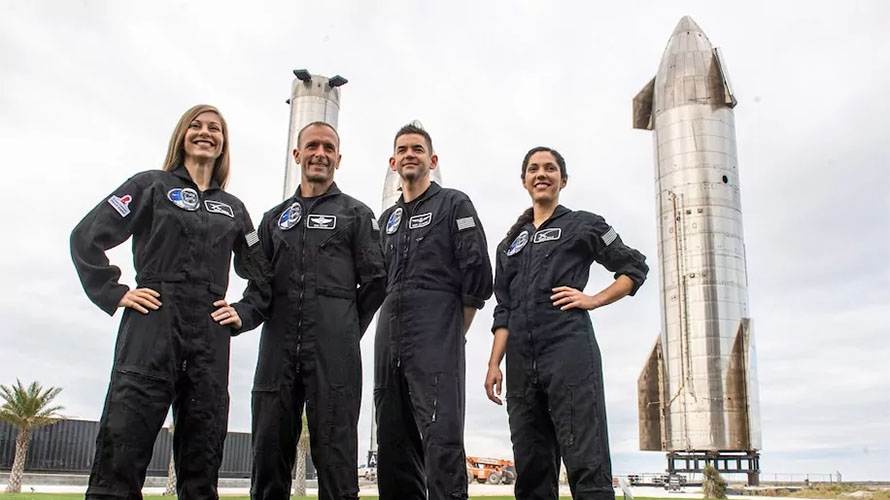A Meditation

By Dale Skran
Image: Polaris Dawn crew courtesy SpaceX.
On February 11th, 2022 Elon Musk gave his long-awaited Starship update, and for some of us it was a bit of a snooze. He provided details about progress on the Raptor 2, but there was very little “news” to those who were already following events in Boca Chica closely. Then, just a few days later on February 14th, the “other shoe” dropped.
Jared Isaacman, the commander of the Inspiration4 “tourist flight” earlier this year, announced that he would lead a series of three flights as part of the “Polaris Program.” The first flight, targeted for No Earlier Than (NET) Q4 2022, and named “Polaris Dawn,” features:
- A crew consisting of Isaacman, Scott Poteet, a retired Air Force pilot and business partner of Isaacman’s, and two SpaceX employees, Sarah Gillis and Anna Menon, flying in a SpaceX Dragon 2 capsule;
- The mission will set a new altitude record for human orbital flight, besting the Gemini 11 1966 record of 1,375 kilometers;
- A variety of scientific experiments;
- A test of inter-satellite communications using Starlink lasers; and
- The first test of the SpaceX extra-vehicular activity (EVA) suits.
Since the Dragon 2 has no airlock, the entire crew must don space suits. When the craft is opened to space, crew members can emerge one at a time. There has been a certain amount of criticism of the space suits, which will apparently depend on an umbilical to the Dragon 2 for life support. Nay-sayers compare the suits unfavorably to current NASA space suits that have large life support packs and allow extended EVAs. Several obvious responses suggest themselves:
- Incremental testing, dude! The Silicon Valley way is build, test, and iterate – FAST! This gets you to a quality end-state more rapidly than a really long design period followed by lots of simulation and finally by a short set of tests, which seems to be the NASA way.
- If your goal is to allow tourists to float about, it is cheaper and relatively safe to require umbilicals.
- Gemini used umbilicals. At the time, nobody trolled NASA about how wimpy the suits were.
- Eventually the SpaceX EVA suits will be used with crewed Starships. Starship is designed so most repair work will be inside the craft, so perhaps there is no actual requirement for very long space walks as is the case with the ISS.
Some media outlets have misrepresented Polaris Dawn as a “tourist” flight, which is just wrong. The presence of two experienced SpaceX engineers emphasizes the practical as opposed to the implied “joyride” aspect of Polaris Dawn. Anna Menon, for example:
- Has a BS in mathematics and Spanish,
- Has an MS in biomedical engineering from Duke,
- Worked as a volunteer on the WHO response to the 2015 Nepal Earthquake focusing on water and sanitation,
- Worked seven years for NASA as an ISS biomedical flight controller, and
- Served as mission director for multiple Dragon missions, worked as Dragon Crew Communications operator, and managed Dragon manufacturing.
Thus, Menon’s qualifications are at least similar to the kind of background typical of NASA astronauts as opposed to “space tourists.”
“Space tourist” Jared Isaacman is also an over-achiever:
- As a 9th grader, he started a computer repair business in his parents’ basement called “Deco Systems,”
- He dropped out of high school to work full time for one of his clients, while obtaining a GED,
- In 1999, he founded and is now CEO of the company that eventually became “Shift4 Payments,” which processes $200B in payments per year,
- Performed in airshows with the Black Diamond Jet Team,
- In 2009, he set a world record for circumnavigating the globe in a light jet (Cessna Citation CJ2) to raise money for the Make-a-Wish Foundation,
- In 2011, he earned a BS in professional aeronautics from Embry-Riddle University,
- In 2012, he co-founded Draken International, a company that trains pilots for the USAF,
- In 2021, he commanded the private Insiration4 Dragon 2 orbital flight to raise money for St. Jude’s Children’s Hospital, and
- Has a net worth of over $2.4 billion dollars.
No doubt many NASA astronauts are more highly skilled than Isaacman, and I am sure Neil Armstrong was the better pilot (mainly because Armstrong may be the GOAT pilot, although I like Scott Crossfield for #2), but Isaacman is far removed from the ordinary “tourist” and his interest in space goes way beyond mere “joyriding.”
Although the financial support of Isaacman surely is welcomed by SpaceX, his presence distracts from the fact that with the Polaris Program, SpaceX is embarking on the first private human space program. Going beyond mere tourist flights, the Polaris Program will dramatically advance human spaceflight at a cost far less than what NASA would spend for the same effort.
Polaris is envisioned as three flights, apparently all to be commanded by Isaacman. The details of the second flight are sketchy, except that it will also be on a Dragon 2. My speculation is that it will involve docking a Dragon 2 to a Starship in orbit, as well testing Starship life support. A possible rationale for this mission is that SpaceX knows NASA will be reluctant to let government crews fly on Starship since it lacks a launch escape system (LES). The easy way around this in the short term is to launch the NASA crews on a Dragon 2, and dock with Starship in orbit. This suggests that the 2nd Polaris mission will be a critical path test for the usage of Starship as a lunar lander as part of NASA’s Artemis return to the Moon.
The third flight was announced as the first up and down crewed Starship flight, obviously a major milestone. In the longer term, Musk seems intent to demonstrate such a high level of reliability with Starship that eventually NASA will come around, and the third Polaris mission will likely be an important step toward that objective.
SpaceX has an ulterior motive for running its own human space program – the need to train astronauts to be ready for the difficult early voyages to Mars. The Polaris program alone will provide space experience for at least six and likely more SpaceX “corporate astronauts.” It is reasonable to expect additional test flights to be paid for by NASA as part of the Artemis program. The short-term goal may be to have a cadre of 6-12 experienced SpaceX personnel ready to go to Mars in 2026. There has been speculation that Isaacman has his eyes on commanding this mission as well, and who is to say that he won’t? After the Polaris missions, he will be one of a small number of astronauts with both Dragon 2 and Starship flight experience. Maybe when Isaacman steps out on Mars the Internet trolls will admit that he is, at long a last, a “real astronaut.” Personally, I don’t think this scenario is very likely, since SpaceX will almost certainly allow NASA to select the first American to walk on Mars. The goal of SpaceX is not, after all, to send the first human to Mars. It is to send the first million humans to Mars.
I admit that even I, a life-long dedicated space development and settlement advocate, feel a bit trepidated about the sudden arrival of the Polaris Program. It is one thing to dream, hope, and work toward a future in which space is open to anyone who wants to go, and quite another thing to see it start to happen. Yes, I know that the crew of Inspiration4 or Polaris Dawn does not truly represent the “democratization of space” (right now, cubesats are the engine democratizing space), nor does it represent the “privatization of space” (since no public enterprise is being made private), but it is the first step toward a future in which most people in space are private actors, just as here on Earth, where most of us are not government employees.
The epoch of an elite of carefully chosen government astronauts leading the way into space is drawing to a close, and I feel more than a few pangs of nostalgia at its passing, but people like Isaacman, Menon, Poteet, and Gillis are the vanguard of a bright new age in space. Polaris is the next step on the journey leading to human communities in space. You can follow their training at polarisprogram.com. They seem pretty busy. So, three cheers to Jared Isaacman and the brave crew of Polaris Dawn.
© 2022 Dale Skran



















